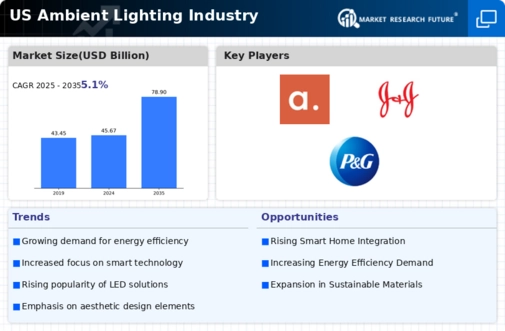Technological Advancements in Lighting
The ambient lighting market is experiencing a surge due to rapid technological advancements. Innovations in LED technology, for instance, have led to more energy-efficient and longer-lasting lighting solutions. The integration of smart technologies, such as IoT and automation, allows consumers to control their lighting systems remotely, enhancing user experience. In 2025, the market for smart lighting solutions is projected to reach approximately $10 billion in the US, indicating a robust growth trajectory. These advancements not only improve functionality but also contribute to the aesthetic appeal of spaces, making them more attractive to consumers. As technology continues to evolve, the ambient lighting market is likely to benefit from increased adoption rates and consumer interest, further driving market growth.
Growing Demand for Sustainable Solutions
Sustainability is becoming a pivotal driver in the ambient lighting market. Consumers are increasingly seeking eco-friendly lighting options that reduce energy consumption and carbon footprints. The shift towards sustainable practices is evident, with a reported 30% increase in the adoption of energy-efficient lighting solutions in residential and commercial sectors. This trend is further supported by government initiatives promoting energy conservation and the use of renewable energy sources. As awareness of environmental issues grows, the ambient lighting market is likely to see a continued rise in demand for products that align with sustainable values. This shift not only benefits the environment but also appeals to a growing demographic of environmentally conscious consumers.
Increased Focus on Health and Well-being
The ambient lighting market is witnessing a heightened focus on health and well-being, particularly in residential and commercial spaces. Research indicates that lighting can significantly impact mood, productivity, and overall health. As a result, there is a growing demand for lighting solutions that promote well-being, such as circadian lighting systems that mimic natural light patterns. In 2025, the market for health-oriented lighting solutions is expected to grow by 25%, reflecting a shift in consumer preferences towards products that enhance quality of life. This trend is likely to drive innovation within the ambient lighting market, as manufacturers develop solutions that cater to the health-conscious consumer.
Rising Urbanization and Smart City Initiatives
Urbanization is a key driver of the ambient lighting market, particularly in the context of smart city initiatives. As cities expand, there is an increasing need for efficient and effective lighting solutions that enhance safety and aesthetics in urban environments. The US government has allocated substantial funding towards smart city projects, which often include advanced lighting systems. This investment is expected to boost the ambient lighting market, with projections indicating a growth rate of 15% annually in urban areas. The integration of smart lighting in public spaces not only improves energy efficiency but also enhances the overall urban experience, making it a critical component of modern city planning.
Evolving Consumer Preferences and Lifestyle Changes
Consumer preferences are evolving, significantly impacting the ambient lighting market. The rise of remote work and flexible living arrangements has led to increased demand for versatile lighting solutions that cater to various activities and moods. In 2025, it is estimated that 40% of consumers will prioritize customizable lighting options in their purchasing decisions. This shift reflects a broader trend towards personalization in home and office environments. As consumers seek to create spaces that reflect their individual styles and needs, the ambient lighting market is likely to adapt by offering a wider range of customizable and aesthetically pleasing products.













Leave a Comment